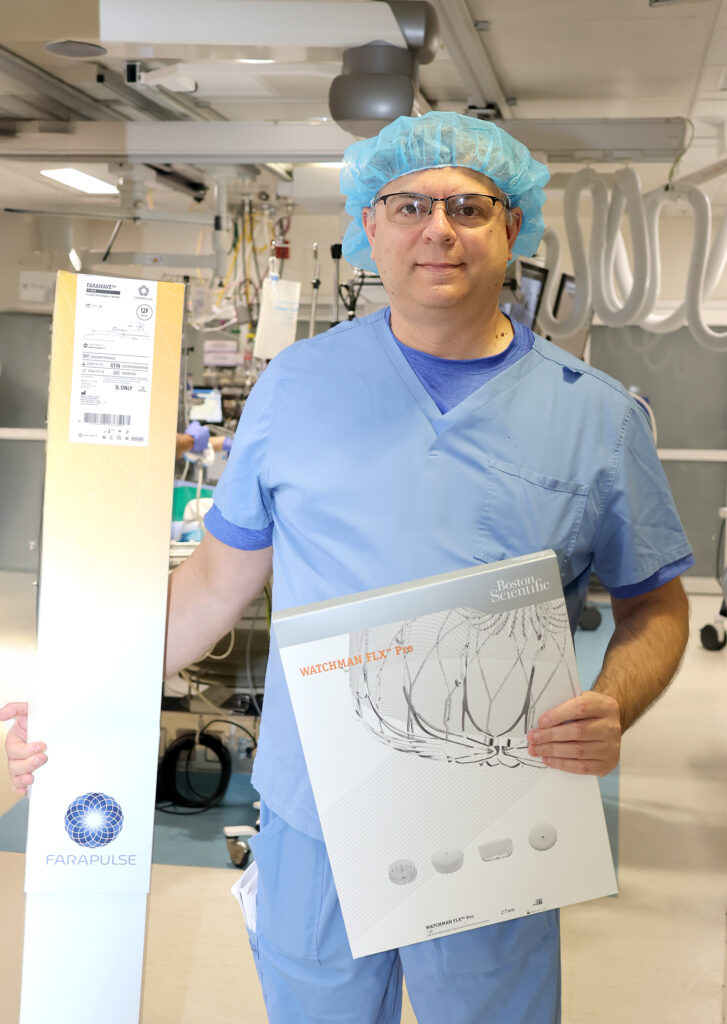Dr. Daniel Friedman conducts first dual procedure at Manatee Memorial Hospital to treat atrial fibrillation and help prevent stoke

Bradenton, FL – (December 4, 2024) – Dr. Daniel Friedman, MD, FHRS, FACC, and his team, recently completed a procedure where he performed both a catheter ablation followed by a left atrial appendage closure where he placed a Watchman® implant. The procedure was performed in the Cath Lab at Manatee Memorial Hospital (MMH). The procedure treats atrial fibrillation with an ablation then closes the appendage, so the patient is no longer dependent on blood thinners.

Doctors recommend taking blood thinners after ablation for atrial fibrillation (a type of irregular heartbeat) in patients who have a high risk of stroke. Another option is left atrial appendage closure, a mechanical procedure that can replace the need for blood thinners. However, until recently, there has not been much information about using this procedure after ablation.
To address this, the international OPTION trial that included 1,600 patients with moderate to high risk for stroke, determined that the left atrial appendage closure can safely reduce the risk of bleeding from blood thinners while still keeping a low risk of stroke in patients with atrial fibrillation who have had catheter ablation.
“The benefit to the patient is that they can get both procedures completed in one visit and are note dependent on blood thinners,” added Dr. Friedman who served as a principal investigator for the OPTION trial at MMH.
Catheter ablation is an effective way to treat atrial fibrillation when it causes noticeable symptoms. However, since atrial fibrillation can reappear, even with mild symptoms, current guidelines recommend that patients at moderate or high risk of stroke continue taking blood thinners permanently, no matter how successful the ablation seems. Blood thinner therapy has its downsides, including the risk of bleeding, patient worry and high costs. Because of these challenges, about one in four patients stops taking blood thinners within a year of starting them. Using a catheter to close the left atrial appendage is another way to prevent strokes. Its safety and effectiveness have been proven when compared to common blood thinners.
About Atrial Fibrillation
Atrial fibrillation (AF) occurs when the top two chambers of the heart, the atria, beat too fast and with an irregular rhythm (fibrillation). AF, the most common type of arrhythmia, can decrease the heart’s pumping efficiency, which can cause blood cells to pool and stick together, forming clots in the heart, and lead to stroke. People with AF have a higher risk of stroke, heart failure and other heart-related complications than those with normal heart rhythms.
The OPTION trial
The OPTION trial was a multicenter, randomized clinical trial. The trial protocol has been published previouslyand is available with the full text of this article at www.NEJM.org. The trial was funded by the manufacturer of the left atrial appendage closure device (WATCHMAN FLX®, Boston Scientific). The trial was designed by a steering committee in collaboration with the sponsor and the Food and Drug Administration. – New England Journal of Medicine.
About Manatee Health
Proudly serving the residents of Manatee, Hillsborough, and surrounding counties for more than 70 years, Manatee Health represents an entire network of healthcare services. These include freestanding emergency departments, outpatient imaging, rehabilitation and sports medicine, home health, surgical and specialty physician services, and all the inpatient services offered by Manatee Memorial Hospital including advanced stroke care and vascular disease, emergency medicine for all ages; cardiac; cardiovascular; surgical, including robotic; orthopedics; respiratory care; sleep services; oncology; wound care and women’s and children’s services including Manatee County’s only Level II Neonatal Intensive Care Unit. For information on hospital services, visit manateehealth.com.
